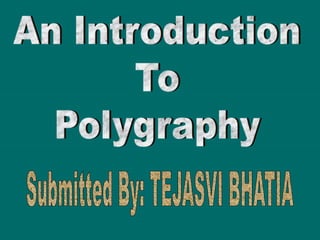
Polygraphy
- 2. Introduction History Objective Equipment Requirement Preparation of question Examination procedure Post-test session Analysis of polygraph chart Interpretation of results Limitations References
- 3. This technique of the detection of deception is based on the principle of psychosomatic interactions within an individual. For this an instrument named ‘Polygraph’ is used which can measure and records several physiological responses such as blood pressure pulse, respiration (breathing) rhythms, body temperature and skin conductivity while the subject is asked and answers a series of questions.
- 4. This is based on the fact that the fear of detection and entrapment induces certain physiological reactions in the body, when an individual consciously attempts to deceive any information. These changes are caused by nervous system. This polygraph examination can also be known as psychophysiological detection of deception.
- 5. The idea that lying produces physical side effects firstly started in West Africa. Early devices include Cesar Lombroso’s (1885) invention that measured change in blood pressure and in 1914 another device was invented which measured breathing.
- 6. The term polygraph was coined by James Mackenzie in 1906. he firstly tried his invention ‘the ink polygraph’ for medical use. More advanced polygraph was invented in 1915 by Harvard trained William Moulton Marston and claimed that it could detect lies by measuring blood pressure. In India tech. was introduced in year 1972-73 at Central Forensic Science Laboratory (CFSL), CBI New Delhi.
- 7. To verify the veracity of the statement of suspect, witness and complainant in all types of crimes. To replace the third degree method of interrogation in scientific manner. To examine white-collar criminals, economic offenders, and other offenders. To economize the process of investigation by screening large number of suspects by differentiating between the guilty and the innocent. To refute the findings of the investigation.
- 8. The equipment which is used for the purpose of lie detection is the ‘polygraph’. The word polygraph means many writings simultaneously As the name indicate the equipment, simultaneously, can record more then one physiological response and changes in them Pneumograph: to record respiration, partially inflated rubber tube is fastened around thoracic and/or abdominal region of the examinee
- 9. Sphygmomanograph: A blood pressure cuff is fastened around the right arm Galvanograph: electrodes are attached to the index finger and the ring finger of the left hand for recording the galvanic skin resistance
- 10. The examiner The examinee Polygraph examination room Privacy Consent of the examinee
- 11. It involves discussion with the investigating officer in detail and finalizing the issues for conducting the polygraph examination Pre-test interview of the subject with the examiner. It helps to bring the subject into a proper psychological set. the background information form, and non verbal clue form, are filled up in order to collect information from the subject regarding his medical, psychological ,personal history, and crime record.
- 12. On the basis of the above information three type of questions are prepared. Irrelevant questions: these are not related to the crime under investigation or any other crime. These are included because ans. To these questions are admitted truth Control questions: these questions are capable of provoking emotions, usually about an wrong act which in general similar to the issue under investigation. These are less serious in nature and in all probability the examinee will lie. relevant questions: these are directly related to crime under investigation
- 13. It involve following steps familiarize the examinee with the examination room, polygraph equipment and its attachments instruct the examinee about the manner in which he has to sit during the examination attach the sensors on the examinee Record the normal physiological parameters after the sensors are attached to the examinee.
- 14. instruct the examinee regarding the administration of the questionnaire pre test recording is done after the introduction and review of the questionnaire to the examiner in order to see the impact of introduction of the questionnaire administration of the questionnaire
- 15. Get the signature or the thumb impression of the examinee on the polygraph charts and questionnaires Post test interview – this helps the examinee to understand the meaning and the consequences of the polygraph examination results.
- 16. Steps followed in analyzing the charts are as follows: Draw the lines on polygrams at the beginning of each question i.e. question time and when the examinee reply the question i.e. reaction time. Observe the patterns of normal recordings in all the four parameters. polygraph chart tracing is divided in to four tracing segments:- Average- tracing segments: tracing interpreted as normal tracing without stress.
- 17. Reaction – tracing segment: tracing interpreted as having observable physiological changes while answering the relevant questions. Relief – tracing segment: tracing interpreted as having relief reaction after answering relevant questions. Distorted – tracing segments: tracing not arising out of deception but occurs because of other factors.
- 18. Observe the normal recordings of physiological parameters. Compare the recordings of each physiological parameter on each relevant question with respect to normal recordings, pretest recordings, recordings on comparison questions and recordings on irrelevant question. Mark the reactions on each and every question on all the polygrams. Sequential analysis is done for each run separately and the final conclusion is based on the average score of all the runs.
- 19. During examination certain precautions have to be taken by the examiner in order to avoid wrong opinion formation: mental tension of the subject unresponsiveness of the subject some unobserved muscular movements Physiological defects like hearing, impairment, neurological impairment etc. mental abnormalities These limitations can be eliminated by strictly following the conditions essential for successful operation of the polygraph examination.
- 20. Sharma .B.R.(1990): Forensic Science in Criminal Investigation and Trials. Klenier.Murry(2000): Handbook of Polygraph testing. http://people.howstuffworks.com/lie-detector.htm http://www.polygraph.org/ http://skepdic.com/polygrap.html http://truth.boisestate.edu/polygraph/polylaw.html http://www.crimelibrary.com/criminal_mind/forensics/p olygraph/1.html
